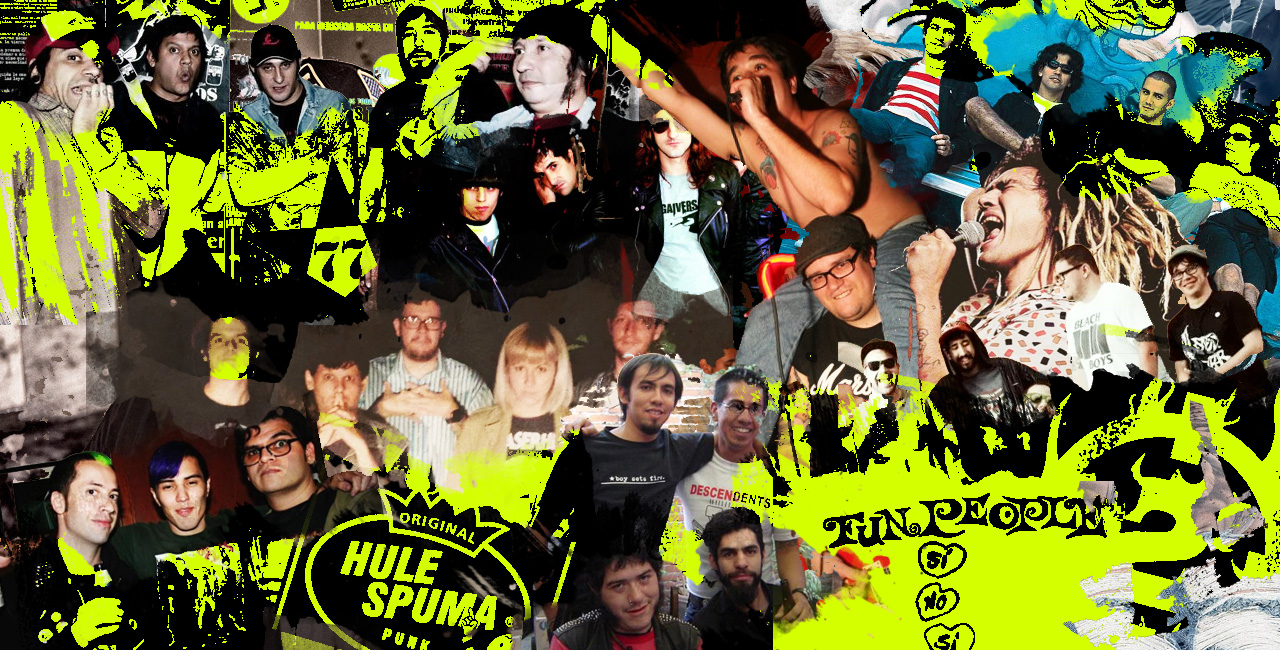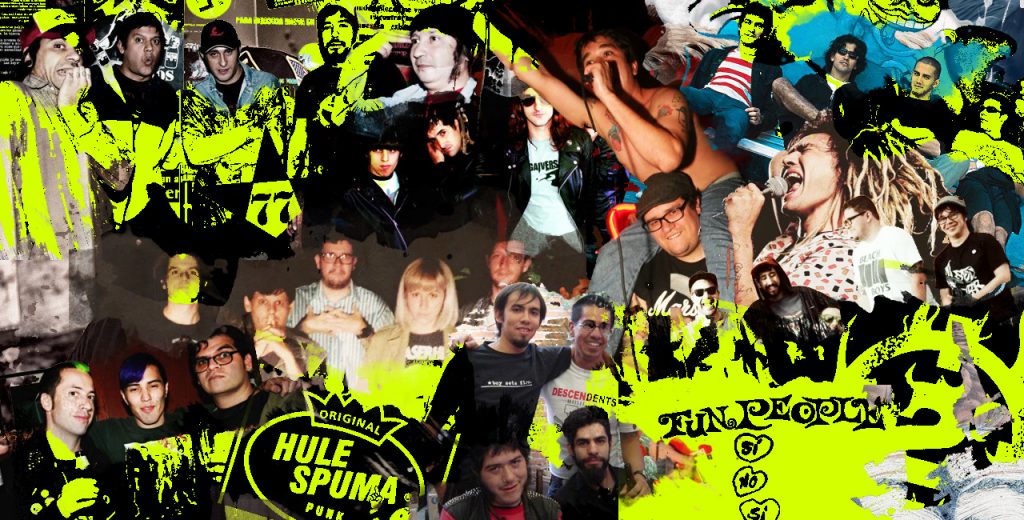As pop punk soars into another plane of popularity, its stylistic reach expands — again. Authenticity has continually shifted for the whole genre; as scholar and zine author Mimi Thi Nguyen so aptly wrote, “Punk is a moving target.” And when it’s pop punk that’s in question, the ebb and flow of mainstream acceptance has swayed its limits — defining what counts as real pop punk is increasingly difficult.
We can, however, recognize movements, and we can pinpoint the leaders within them. In Latin American pop punk, there’s a handful of bands that are inarguably groundbreaking. They are the ones who paved the way for today’s current crop, from the agreed-upon legit sector to the much-contested too-pop-to-be-punk fringes. Of course, Spanish bands like No Picky and Airbag were in dialogue with some of these acts, but we’ve decided to highlight the Latin American talent this time around. A list like this can never be complete, but the batch below is a selection of pop punk anchors that can’t be denied. –Jhoni Jackson
Stream some of our favorite tracks from the artists below via Apple Music. Special thanks to Gabo Rodriguez.
1
301 Izquierda (Mexico)
Founded in 1995, 301 Izquierda lasted for 10 years before disbanding, but the impact they had on a generation of skaters and teenagers was enormous. They made their name on the stage of the legendary Multiforo Alicia along with fellow acts like Gula, Ducto, Axpi and many more, singing rapid-fire songs about the perils of growing up. Their album No Es Necesario remains one of the era’s definitive cultural artifacts, containing their most popular song “Calcetas,” an earnest ode to lost love that was later covered by Allison, one of the most popular bands in the emo scene (which ironically had violent clashes with punks that resulted in extensive media scandals). After the breakup of 301, singer Tío joined crust punk legends Antimäster before forming the furious Crimen with Eumir from Big Spin. –Marcos Hassan
2
Hulespuma (Mexico)
During the peak years of Mexican pop punk, the genre was referred to as “happy punk,” a term that eventually became an insult to both bands and fans. If there was a group that embodied that label before it became uncool, it was Hulespuma. They were lightning-fast and saccharine-sweet in their hooks, slightly snotty but always wore their hearts on their sleeves. Hulespuma was one of the most noteworthy bands of the early scene, with tracks on the legendary Prueba Esto compilation, anthems like “Quiero Saber,” and their album Egon. Guitarist Christian left the band to help form Austin TV, a historic force in Mexican rock, before returning to punk with his recent project Dolores De Huevos. A few years ago, Hulespuma joined forces once again for a special reunion tour. –Marcos Hassan
3
2 Minutos (Argentina)
One of the biggest bands in the genre, Buenos Aires’ 2 Minutos were filling up stadiums in their home country even when punk was just a novelty in the U.S. mainstream. Their brand of punk owes a lot to Oi!, the British subgenre closely associated with drinking and hooliganism, which the band used to pen playful anthems about fighting and fútbol. They might not have the most cerebral of hooks, but their greatest songs beg to be screamed arm in arm with strangers in the mosh pit. They probably qualify as the premier Argentine punk band, since they got to play CBGB’s in 1995. Check their catalog for unforgettable anthems like “Ya No Sos Igual,” “Lejos Estoy,” and “Canción de Amor (Cerveza).” –Marcos Hassan
4
Anti-Sociales (Puerto Rico)
While the bulk of the best-known Puerto Rican punk, pop, or hardcore or otherwise, is concentrated in San Juan, Anti-Sociales technically hails from Aguadilla, a comparably sleepier northwestern municipality with a population five times lower than the metro’s. Anti-Sociales’ singularity isn’t a result of that, though: The band stands out as one of the island’s oldest — and still active — pop punk acts.
Barely in their teens and within a year of forming, they penned the scrappy, hyper-speed tunes of ¿A esto le llaman punk rock?, the iconic full-length named for the subject of a naysayer’s email received in their first year of existence. Jan Coztás, the only founding member remaining from that 2001 start, noted the joke in a post for local punk blog Reloj Bomba — and also recalled the extensive cross-pollination, typical of any small underground scene, of a revolving roster that once included members from Dávila 666 and Campo-Formio, plus Luis Marrero of Los Pepiniyoz. Even Reanimadores’ Nelvin Lara once practiced with them.
Anti-Sociales celebrated 15 earthly rotations last year with a fifth LP: Es Absurdo, recorded with a lineup that’s not quite today’s. Hommy Cabrera, drummer for longstanding hardcore punk outfit Un Final Fatal, is now the sole singer, while Edert Tristani plays guitar alongside Coztás, former Juventud Crasa and Tropiezo player Edwin “Aby” Ojeda drums, and punk scene newcomer Ien Reyes handles bass.
Mutations and relocations aside, Coztás has persevered, the perennial pop-punk combo of restless overactivity — and a dash of puerility — sturdily intact. –Jhoni Jackson
5
Fun People/Boom Boom Kid (Argentina)
One of the most beloved figures in the history of pop punk en español (or Spanglish, more likely), Carlos “Nekro” Rodriguez made history with two of the most essential projects in the Cono Sur. Rodriguez’s hardcore punk band Fun People mixed a melodic approach with lyrics focusing on social issues like LGBTQ and animal rights, all while maintaining a strictly DIY model, releasing music only on their own Ugly Records label. Fun People never compromised their vision and explored different genres, exemplified by their 90s albums Anesthesia and Kum Kum – something Rodriguez explored more extensively with Boom Boom Kid, the stage name he adopted as Fun People were breaking up. While Boom Boom Kid followed the melodic hardcore model of FP, Rodriguez has tinkered with everything from crossover thrash to tango and bolero, and remains an active touring musician. –Marcos Hassan
6
Los Pepiniyoz (Puerto Rico)
It’s always raining in Bayamón, as local joke-lore goes. That perpetual gloominess can be a permanent mood-dampener — it’s worth considering the municipality’s mainstay pop punk band, Los Pepiniyoz, is intrinsically downcast. They even named their 2005 sophomore LP after the city’s cloudy reputation.
But Lluvia, Lluvia, Lluvia, like the rest of “rokirol” band’s catalog, is melodically spirited, often so intensely that it rings like an obvious façade, a transparent coping mechanism for the darkness that pervades the songs thematically. Their most recent, Alta Tension, released two years ago, follows in sad suit — yet the inciting of an album-long pogo and plenty head-bops are inevitable.
Like Anti-Sociales, Los Pepiniyoz have been making the rounds since the early 2000s, and have endured despite several lineup shifts. Frontman Rene D. Cervoni stands as the solo founding member left; his brother, former Dávila player and current Ardillas singer Giancarlo Cervoni, plays bass; Zuania Colon rips on rhythm guitar while Edert Tristani (from Anti-Sociales) takes lead and Miles Ezra Freeborn, a Seattle expat, is on drums. –Jhoni Jackson
7
Kabezudos de Villabajo (Puerto Rico)
They were hardcore punk, they dipped into thrash and Oi at times, and sometimes and they were pop punk, too — but never all at once. At times, frontman José “Chepi” Latorre is practically rapping. All that oscillating could alienate some listeners, but instead they actually helped cement a new wave within the scene, strengthening it as a community in the process. Mid-90s onward, Kabezudos de Villabajo were sure-footed favorites in a now-iconic moment in Puerto Rican punk, back when veteran acts like Golpe Justo reigned, and Juventud Crasa, Lácteos, and Tropiezo first launched (Check the 2002 Nuestro Punto de Vista comp for an emblematic roundup of that era). Hailing from San Sebastian, two hours west of San Juan, Kabezudos de Villabajo helped usher in more long-distance collaboration, fermenting an island-wide scene, albeit with area-specific pockets still individually thriving.
Sadly, Chepi passed in 2010. Multiple memorial fests have been held since, and a tribute comp, featuring both local old-school punks and groups formed more recently, was released just three years back. Undeniably, the mark Kabezudos de Villabajo left on Puerto Rican punk is indelibly historic. Their entire discography is archived on Reloj Bomba here. –Jhoni Jackson
8
Attaque 77 (Argentina)
This Buenos Aires band used to jokingly call themselves Namores — a mash-up of the Ramones and a Marvel underwater anti-hero, Namor the Sub-Mariner. Trivia notwithstanding, there’d still be no denying The Ramones majorly influenced Attaque 77. Dulce Navidad, their 1989 debut, closely mirrors the iconic proto-punk sound, albeit a Spanish-language version; “Me Volviste a Engañar” and “Caminando por el Microcentro” are especially on-point clones. That’s not to say it was all duplicates and carbon copies though. Between the gnarl founding frontman Ciro Pertusi sporadically reaches and those wilder moments between verses when rogue riffs run amok briefly before returning to earworm form, Attaque 77 cultivated its own blend. New wave was an influence, too — hence the namesake nod to the year that genre broke.
A crucial part of the Invasion 88 comp and a cornerstone of Radio Tripoli, the pioneering imprint that released it, Attaque 77 not only helped spearhead the Argentine punk movement of the 80s, but also they’re part of what led to its explosion into mainstream consciousness. Of all the bands of that era, this one remains the most legendary. –Jhoni Jackson
9
Expulsados (Argentina)
After only two demos, Expulsados earned themselves a slot opening for Attaque 77 in 1996 and, like their Argentine punk forebearers, they also carry a white-hot torch for The Ramones (They even adopted the trademark haircuts in their early days, and their leather jackets are probably literally second skin by now). Seriously, through the 2000s — that period where emphasizing the pop in pop punk became especially lucrative, and on the indie side, emo was huge — they continued churning out the same strain of leisurely bouncy punk rock they started with. All that’s changed around that era — Carretera Nocturna, 24Hs. en el Cine, Cuarto para Espectros — is the added sheen of better production, and it’s subtle enough that it helps, not hurts. That trifecta is a catalog highlight, really.
The band has undergone a slew of lineup changes since the late 90s, leaving founding frontman Sebastián as the only original Expulsado standing — but with new members in the mix, Expulsados are still performing their hits, from 1994’s Todo Me Sale Mal all the way through the proto-punk’d covers of Artopalantes 1 and 2. –Jhoni Jackson




